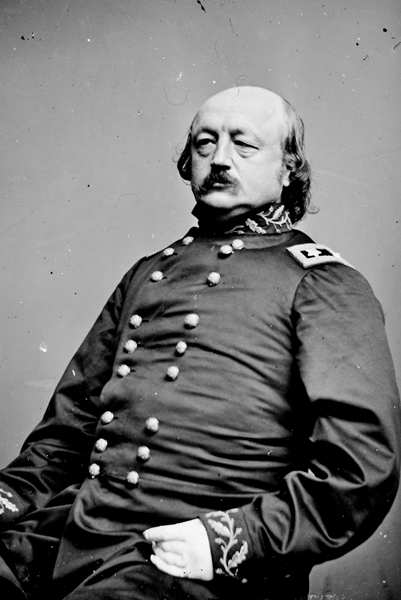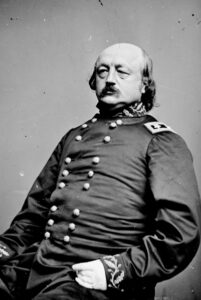Unionist Troops in Louisiana
Five thousand to ten thousand white Louisianans fought for the Union during the Civil War.

Courtesy of Library of Congress Prints and Photographs Division
General Benjamin F. Butler. Unidentified
More than one hundred thousand white Southerners fought for the Union during the Civil War, including between five thousand to ten thousand Louisianans; these Southerners who supported the US federal government were referred to as Unionists. Historians have generally attributed this defiance of regional allegiance to a class revolt against the planter elite who, by their own political machinations, had orchestrated a “rich man’s war and a poor man’s fight.”
Before the pivotal Battle of Shiloh (Tennessee) in April 1862, Abraham Lincoln believed nonslaveholding Southerners, who made up eighty percent of the population, would foment a counterrevolution against the “slave power” that had dragged the South unwittingly out of the Union. Nevertheless, the Battle of Shiloh proved that both sides were willing to take horrific causalities: the Union lost 13,047 men and the Confederates lost 10,669 in two days of combat. According to historian James M. McPherson, “Lincoln lost faith in those illusory southern Unionists and became convinced that the rebellion could be put down only by complete conquest.” Yet Unionist troops were useful not only because they bolstered the ranks of the northern armies but also because those men did not serve the Confederacy. As Lincoln wrote of Unionist troops, “One man there is worth two here … [because he] adds one to us and takes one from the enemy.” Unionist troops in occupied areas helped legitimate Unionist political movements, such as the Free State movement of Louisiana.
While officially 5,224 white Louisianans fought for the Union, some historians have estimated that as many as ten thousand troops from occupied Louisiana served in the Union ranks. Shortly after the Federal occupation of New Orleans in May 1862, Union captain John William DeForest noted that “probably half the fellows who defended the forts [Fort Jackson and Fort St. Philip] against us [in April] are already wearing our uniform.” During Union General Benjamin Butler’s nine-month tenure as commander of the Department of the Gulf, it was not uncommon for young men from the New Orleans area to switch their allegiances and volunteer for Union service. Roughly two thousand local recruits filled existing Union regiments, and Butler recruited two thousand more local white men for two new infantry regiments and one cavalry regiment.
Butler deemed his force of fourteen thousand men inadequate to protect New Orleans and occupy South Louisiana. On June 10, 1862, he wrote Secretary of War Edwin M. Stanton: “I beg to call attention to the need we have for more men here. … [I]f the Department will allow me, I can enlist in sixty days 5,000 men and arm them—the uniforms to be supplied from the North.” Adjutant General Lorenzo Thomas immediately responded, “The Secretary of War received your dispatches last night. … He authorizes you to raise 5,000 loyal white men, to be organized in regiments and officered by you.” Butler immediately raised the First Louisiana Infantry and later in his tenure raised the Second Louisiana Infantry and the First Louisiana Cavalry. In addition, Butler raised three African American regiments of free men of color and ex-slaves.
In The Civil War in Louisiana, historian John David Winters attributed early enlistments to “Germans, Irish, French, and Americans” in New Orleans who were “feeling the pangs of hunger.” While the Union volunteers were overwhelmingly foreign born—with the majority being Irish and German immigrants—Winters failed to take New Orleans’s ethic rivalries into account. In 1860 New Orleans was roughly forty percent foreign born, with large numbers of Irish immigrants who had fled the potato famine of their homeland and German refugees from the European revolutions of 1848. Between 1853 and 1862, New Orleans politics was dominated by the anti-immigrant Know-Nothing, or American, Party. Know-Nothingism was a way for the Anglo-American population to wrest control of city politics from the French Creoles. Because the Irish and some of the Germans tended to support the Democratic Party that kept the Creoles in power, the American Party employed native-born thugs to bash immigrants at the polls. Immigrants were not only shut out of the political process, they were also purged from patronage jobs such as the police force. In the elections of 1856 and 1860, immigrant voting was negligible.
After living under a Know-Nothing regime that embraced secession and the Confederacy, it is hardly surprising the foreigners and “outsiders” (those who were born or lived in other states) constituted the majority of white Unionist volunteers. For example, according to an 1867 account of the history of the 13th Connecticut infantry regiment, of the 220 men recruited to serve, “Nearly all were of foreign birth … Company H received twenty four recruits in May. Of these, twelve were born in Ireland, ten in Germany, one in New York, and one in Massachusetts.” According to Connecticut chaplain George Hepworth, the First Louisiana Infantry included “twenty-seven different nationalities. … Every spot on the Globe from China to Peru, seems to have sent its quota to fill up the ranks.” An in-depth survey of the Second Louisiana Infantry not only reveals that seventy-seven percent of the regiment was foreign born, but also fully ninety percent of the regiment hailed from outside the Confederate states.
As with their African American counterparts in the Native Guard regiments, Louisiana white volunteers bolstered the size of a Union army that was relatively small compared to other departments. During his tenure in 1862, Butler formed the First Louisiana Infantry, the First Louisiana Cavalry, and the Second Louisiana Infantry. Nathaniel Banks, who succeeded Butler in December of 1862, organized the Second Louisiana Cavalry in 1863 and the First and Second New Orleans Infantry regiments in 1864.
The First Louisiana Infantry initially served in General Godfrey Weitzel’s brigade and pursued Confederate guerrilla units along Bayou Lafourche. After the Teche Campaign in April 1863, the First Louisiana took part in the battle and subsequent siege of Port Hudson. The commander, Colonel Richard Holcomb, along with thirty of his men died in one of the unsuccessful assaults on the breastworks (the First Louisiana Native Guards left thirty-four men dead on the battlefield, and the Second Louisiana lost thirty-two men). Only the Fourth Wisconsin paid a higher price than did the Louisiana units, losing forty-nine men in the assault. In the spring of 1864, the First Louisiana also participated in Nathaniel Banks’s ignominious Red River Campaign, where the Union army was soundly defeated at Mansfield, just south of Shreveport.
The Second Louisiana Infantry took part in the advance on Port Hudson (Plains Store) and the siege. In September 1863, the Second Louisiana became a mounted infantry unit in order to engage the enemy as skirmishers while the other units fell into place. The Second Louisiana participated in the advance on Western Louisiana, a failed attempt to oust the Confederates and establish a foothold in Texas. After serving in the Red River campaign, the Second Louisiana remained in Baton Rouge for the duration of the war.
The First Louisiana Cavalry saw the most action of all the Louisiana units participating in all the major engagements: the Union victory at Labadieville, the Teche Campaign, the advance and siege of Port Hudson, and the ill-fated campaigns in Western Louisiana and the Red River. The First Louisiana Cavalry was the only Louisiana Unionist regiment that saw action outside of Louisiana in the spring of 1865, when it advanced on Mobile, Alabama. In 1863, as the war progressed, the First Louisiana Cavalry absorbed the Second Rhode Island Cavalry into its ranks; in 1864 it consolidated with the Second Louisiana Cavalry.
The First and Second New Orleans Infantry regiments numbered just over five hundred volunteers and were consolidated into one unit. By 1864, after the fall of Port Hudson, the New Orleans economy provided opportunities for skilled as well as unskilled labor as alternatives to army service. As a result, Banks instituted a draft to fill up depleted ranks after Port Hudson, but there was little military action in the state after 1864, and units such as the New Orleans Infantry acted as home guard regiments.
Two Louisiana volunteers acquitted themselves with distinction by receiving the Medal of Honor: Jean Beaufort of the Second Louisiana Infantry for gallantry at Port Hudson, and Thomas Riley of the First Louisiana Cavalry for capturing the enemy battle flag at Fort Blakely, Alabama. Nevertheless, Union volunteers served a political purpose that exceeded their military accomplishments by symbolically legitimating the Free State Movement, an effort by Louisiana Unionists to steer Louisiana back into the United States as a reconstructed state. Banks, who was far more savvy in politics than in generalship, wrote to Abraham Lincoln that “the amalgamation of the people of the rebel States with the army of the Union will be the first and strongest proof of the restoration of government.”
Unionist regiments were part of a larger political movement for integrating Louisiana back into the union. Wartime service as well as the Free State Movement gave Louisiana’s immigrant populations political legitimacy that had eluded them under the Know-Nothing regime of the antebellum period. In what would have been unthinkable before the war, voters from New Orleans and occupied Louisiana elected German immigrant Michael Hahn governor in 1864.
